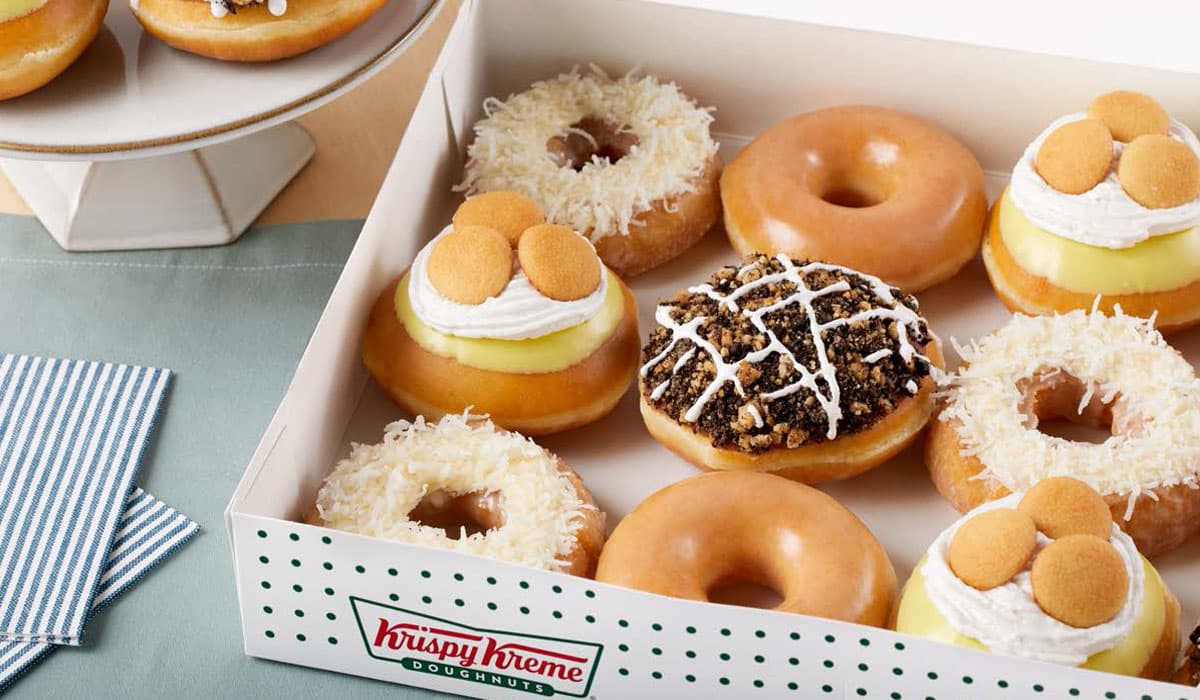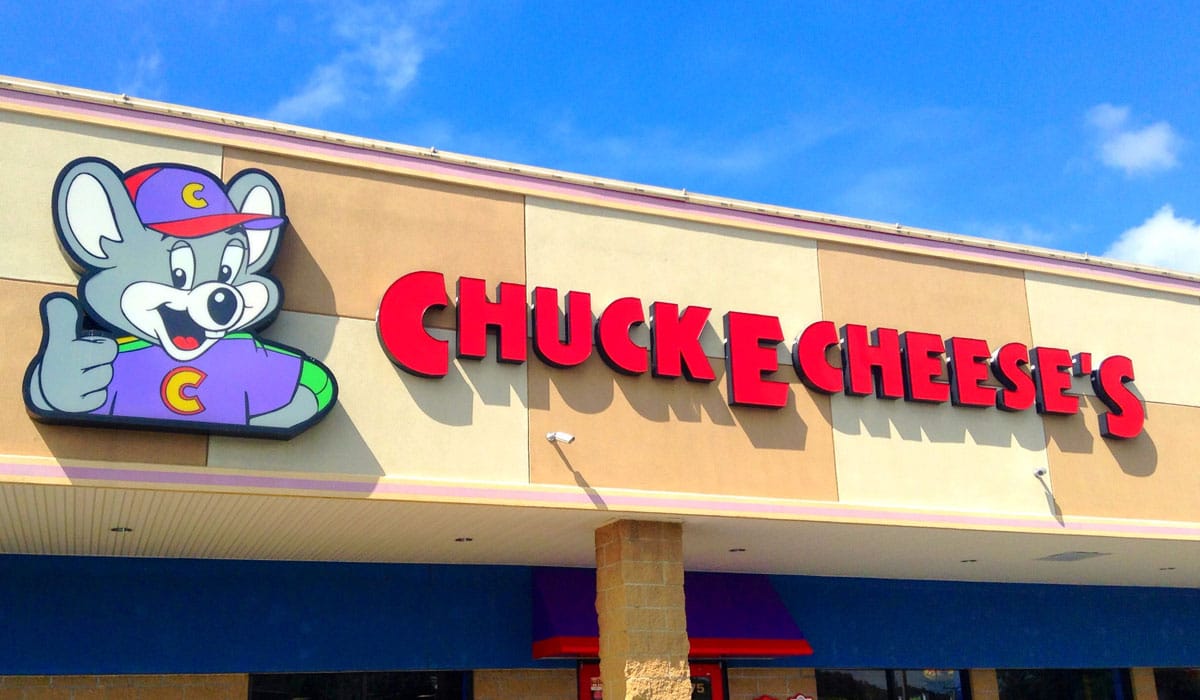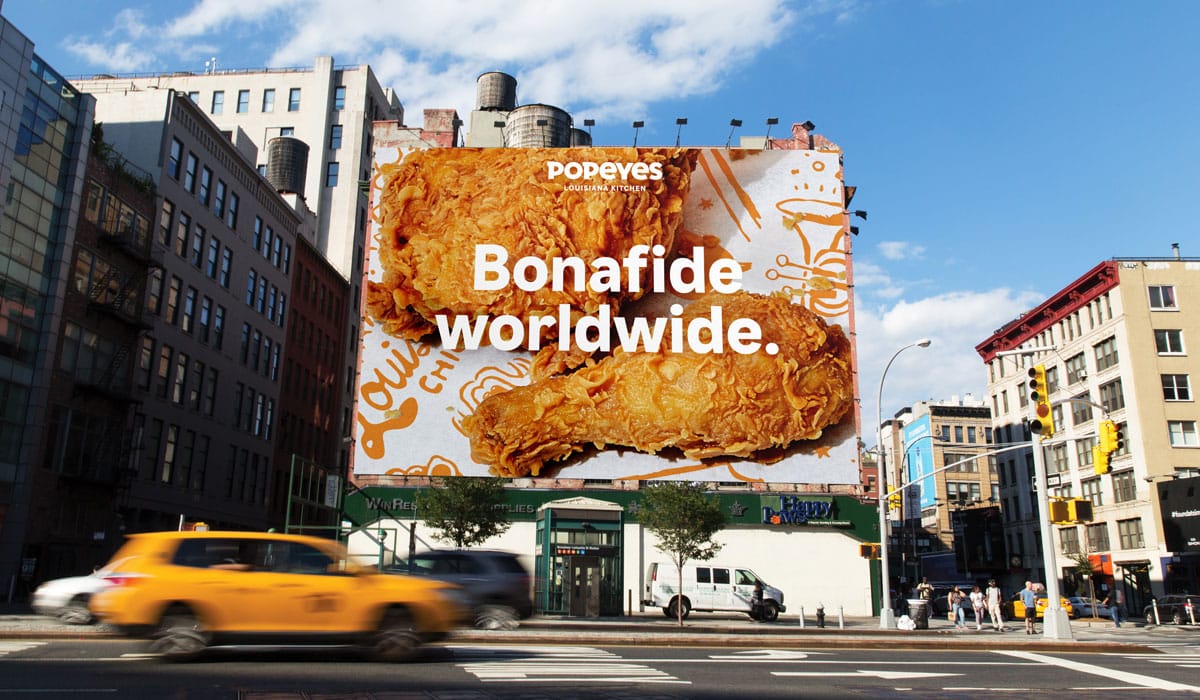McDonald’s Big Mac. Burger King’s Whopper. KFC’s Original Recipe. Arby’s Classic Roast Beef. Dairy Queen’s Blizzard.
The quick-service restaurant industry is built on the wrappers and clamshells of iconic menu items, billons of dollars spent every year on food that exists as much in the cultural zeitgeist as it does in the grease-flecked bags served out of fast-food windows across America.
And in 2019, another menu item climbed to the highest reaches of cultural relevance: Popeyes’ Chicken Sandwich. The sandwich—made up of a buttermilk-battered and hand-breaded white-meat chicken filet, two barrel-cured pickles, and a choice of classic mayo or a spicy Cajun spread, all on a toasted brioche bun—launched nationally on August 12, 2019, and two weeks and one very powerful tweet later, entered menu-development lore by selling out its entire supply.
It was one of the most astonishing product launches in restaurant history, one that took even the company completely by surprise. “We had an internal projection, which was aggressive, and we were ready to supply our restaurants with almost three times that internal projection,” says Felipe Athayde, president, Americas, at Popeyes. “We thought we were good. And once this thing materialized, it was three-and-a-half times the number that we had supply-wise. It was just impossible to predict. We were blown away.”
Better yet? The Chicken Sandwich wasn’t some flash in the pan. And it even proved immune to one of the most challenging crises in modern restaurant history.
Developing an icon
There may be only four ingredients that come together in the Chicken Sandwich, but don’t be fooled by the simplicity. It took about two years to develop the new product, a process that began just after Popeyes was acquired by Restaurant Brands International (RBI), parent also to Burger King and Tim Hortons.
Athayde says the goal in that development process was to create something that could be iconic to the Popeyes brand, which meant ensuring each ingredient was best-in-class and being highly intentional about every single detail, from taste to crunchiness.
“We knew that the sandwich category and the boneless [chicken] category were both super important in the [quick-service] industry,” he says. “And we saw this as a huge opportunity for us to expand into those categories.”

That’s wasn’t based on just a hunch. The NPD Group reported that, for the year ending February 2019, 4 billion chicken sandwiches were ordered at U.S. restaurants, up 4 percent from the previous year. That’s compared to 8.6 billion burgers, a number that was flat over the prior year. And as analyst Lauren Silberman of investment bank Credit Suisse points out, what’s noteworthy isn’t just how many more chicken sandwiches are getting sold, but who they’re getting sold to. “It appeals more to females, and that’s a key demographic to get into,” she says. “And when you think of millennials and younger people, they’ve been shifting toward boneless categories as opposed to bone-in.”
Of course, the chicken-sandwich game isn’t exactly a new frontier. A certain Atlanta-based behemoth has built its empire with a chicken sandwich as its star item. Indeed, Chick-fil-A’s dominance in the chicken-sandwich space wasn’t lost on Popeyes, which rose to prominence with a bone-in product. That’s why the New Orleans–founded and flavored chain wasn’t afraid to take some shots at Chick-fil-A when it launched its new sandwich.
Or rather, one really powerful, efficient shot. Really, just two words. On August 19, 2019, one week after Popeyes’ Chicken Sandwich launch, Chick-fil-A tweeted a not-so-thinly-veiled nudge at its rival, saying “Bun + Chicken + Pickles = all the [heart emoji] for the original.” In response, Popeyes tweeted simply, “…y’all good?”
It was the tweet read ’round the world. Twitter exploded with likes, retweets, commentary, and memes. Celebrities chimed in. Late-night talk-show hosts joked about it. And just like that, the so-called “Chicken Sandwich Wars” had begun.
THE COVID-19 ROAD FOR RBI SO FAR:
Burger King parent to close ‘several hundred’ restaurants
Burger King Gets Back to Pre-COVID Sales
Restaurant Leaders: We Must Be Part of the Solution
Popeyes, the Pandemic Proof Fast-Food Chain
Popeyes and its Chicken Sandwich are Still Soaring
How Burger King Plans to Keep Guests, Employees Safe as it Reopens
Coronavirus Crisis No Match for Popeyes’ Chicken Sandwich
Popeyes’ Sales Were Surging in Q1
Burger King Parent Advances Cash to Franchisees, Defers Rent
For Popeyes, the results were immediate. People waited hours in line to try the new sandwich. Individual restaurants reportedly sold about 1,000 Chicken Sandwiches a day. And eight days after The Tweet, on August 27, the brand announced to the world that the initial run of the Chicken Sandwich had sold out, even though the company had planned enough product to last through September.
A June report in Ad Age cited Popeyes estimations that the tweet earned more than 20 billion impressions worth about $220 million. By the end of 2019, Popeyes had more than doubled its Twitter followers. Athayde says the brand had planned an ad campaign for around Labor Day of 2019 that would showcase customers enjoying the sandwich, but the campaign was shelved for months because it wasn’t needed.
“It’s incredible the amount of word of mouth and of positive reviews that we have seen,” he says. “It’s incredible how enthusiastic our guests were with the product.”
Enthusiastic might be selling it short. Popeyes enjoyed a 10.2 percent same-store sales bump in 2019’s third quarter, even though the $3.99 Chicken Sandwich graced the menu for just two weeks of the quarter. It returned to menus on November 3—a Sunday, in another shot at Chick-fil-A—and Q4 sales rose a staggering 37.9 percent. In reporting RBI’s 2019 performance in February, CEO Jose Cil said he and others who’d been in the restaurant industry a long time had “never seen the kind of guest response for a single product launch like the one we had for our Popeyes Chicken Sandwich.”
Turns out, Cil was more right than he could have known.


Position of strength
Releasing one of the most successful new products of all time would be enough to make a company’s year eventful. But of course, what lay ahead for the entire restaurant industry in 2020 made the hoopla surrounding the Popeyes’ Chicken Sandwich seem like small potatoes.
Popeyes experienced the coronavirus just like any other restaurant company in the U.S., with sales dropping sharply in mid-March. In reporting Q1 earnings, the company noted that same-store sales were up 30 percent for the quarter, but that for the last couple weeks of Q1, sales were essentially flat over the previous year—still enormously impressive considering the fact that many chains experienced sales drops of 40–50 percent or higher. In Q2, comps lifted 28.5 percent in the U.S.
Popeyes’ momentum with the Chicken Sandwich combined with its wide availability of drive thrus, no breakfast service (the daypart most negatively affected by the coronavirus), and robust digital platform (more on that in a bit) helped the brand sustain COVID-19 better than most.
Daniel Gonzalez, head of finance and development for Popeyes, Americas, says the company’s success leading into 2020 gave it an incredible advantage once COVID-19 struck.
“We were coming from a situation where, going into the pandemic, results were very, very strong, so I think our first thought was really to try to focus on safety and kind of protect the momentum we had built,” he says. “That manifested itself in a way where we were able to quickly manage through.”
The brand implemented many of the same safety measures as other restaurant companies: it rolled out enhanced sanitation, contactless procedures, social distancing between both customers and employees, acrylic counter shields, and temperature checks and face masks for all workers. It also emphasized its off-premises opportunities, particularly drive thru and delivery. On the corporate side, Gonzalez says that within the first week of the pandemic, Popeyes had restructured its team so that they could focus on franchisee profitability and liquidity. They went franchisee by franchisee, looking at balance sheets, searching for liquidity, and assisting where necessary with Paycheck Protection Program (PPP) loans.
“It’s all about delivering what the guest is looking for from a convenience perspective, but from a product offering perspective, as well,” says Felipe Athayde, president, Americas, at Popeyes.
Athayde says the pandemic put into focus for Popeyes how important it was to get all stakeholders—corporate employees, franchisees, even suppliers—on the same page, particularly at a time when so many people started working from home.
“We are very convinced that the best way to deal not only internally with our teams, but externally with our franchisees, is to over-communicate,” he says. “The more that you communicate the situation around you, the more aligned the system is going to be. And you need a system that acts in unison, that’s fully aligned—not only in a situation of a pandemic, but also in a situation of growth.”
Within two months, Popeyes had recovered its momentum. From April 1 through the third full week of May, the brand’s same-store sales surged, increasing by a percentage in the low-40s. And in late May, Popeyes announced a rebranding initiative that simplified its logo and refreshed its store and package designs. The first remodeled store was located near Popeyes’ original hometown of New Orleans, and more will come online through 2021—including in international markets, as Popeyes charts growth in Brazil, Spain, and even China.
It was almost like Popeyes hadn’t missed a beat—like the Chicken Sandwich had given the brand a sort of super power.
“We can follow these procedures and prioritize the safety of our guests and our teams, but also still play offense here,” Gonzalez says. “There’s a big opportunity for us. We think we can do both. We can prioritize safety … but also showcase some of the new and exciting things that we’re doing when the world needs some positive news.”
Better, faster, more convenient
The coronavirus pandemic didn’t bring about the digital pivot for the entire restaurant industry, but it sure did expedite it. Most multiunit brands had already rolled out or were working on things like digital ordering platforms and third-party delivery partnerships, but as those services became necessary due to social distancing and stay-at-home orders, just about everybody running a foodservice operation came online.
Fortunately for Popeyes, it was well prepared for the digital awakening. As part of RBI, the company had already invested heavily in digital tools that supported off-premises sales and managed guest information. Thus, what the Chicken Sandwich and coronavirus pandemic have helped do for Popeyes is two-fold: They’ve delivered new guests who’d maybe never even heard of Popeyes before, much less visited its restaurants, while channeling those guests into digital channels capable of recording massive amounts of data. Company leaders reported on the Q1 earnings call that digital orders represented about 15 percent of Popeyes’ sales, while 20 percent of Popeyes’ delivery orders were flowing through its white-labeled app (thereby giving it access to much more robust data).
“You can send targeted offers to your guests and understand their reaction,” Athayde says. “We’ve been doing a lot of that, really augmenting our digital capabilities. … It’s all about delivering what the guest is looking for from a convenience perspective, but from a product offering perspective, as well. And when you know that specific individual, it’s so much easier to do that.”
[image source_ID=”127996″]
What’s especially critical for Popeyes is how its newfound success isn’t confined to the Chicken Sandwich, nor is it relegated to new customers who are just curious what the fuss is all about. Athayde says that not even half of Popeyes tickets contain the Chicken Sandwich, and the overwhelming majority of those tickets that do also have other things from the menu, like bone-in chicken and sides. Further, he says it’s created another Popeyes occasion for those loyal guests who used to go elsewhere when craving a chicken sandwich.
In other words, Popeyes’ Chicken Sandwich is delivering new customers, increasing traffic from old customers, and driving more sales for the rest of its menu—all while helping Popeyes collect more data on purchasing behavior. It’s about as close to a grand slam product launch as a restaurant can get.
And none of it shows any signs of slowing down. Eric Gonzalez, U.S. restaurants analyst for KeyBanc Capital Markets, says that with so many consumers discovering online ordering from restaurants, there’s likely no going back to old ways.
“When we come out of this, people will figure out, ‘Actually that was a pretty good experience when I ordered online, why don’t I do that more often?’” he says. “If they have a good experience on the digital side, it’s highly likely that they will continue to order that way, and that becomes a more profitable and a more convenient, faster, and just better overall experience for both the consumer and the restaurant.”
Setting the bar high
If you’d asked Athayde or Daniel Gonzalez two years ago what they would have predicted for 2020, chances are their answers would have looked nothing like what’s transpired. Who could have predicted the Chicken Sandwich would become such a sensation? Who would have thought a global pandemic could force a make-or-break reckoning for restaurant companies around the world?
Popeyes did, however, have a blueprint. Athayde says the goal all along has been to turn Popeyes into an “iconic global brand,” while Gonzalez says another aspiration is for the brand’s franchisees to be “the most profitable franchisees out there.”
“I think [the Chicken Sandwich] just took the business and the brand to a whole other level, and it’s encouraging us and our franchisee partners to really think much bigger and long-term about growth into the future,” Gonzalez says. “It’s a big tailwind. … We’re always ambitious here, but I think it’s so positive that really anything is on the table. We’re thinking as aggressively and as optimistically as we can about growth into the future.”
That’s especially true of unit expansion. Popeyes is gunning for more restaurants in the U.S. and abroad, with the one-two punch of the Chicken Sandwich and the new store design being selling points. A big advantage the brand now has is RBI, which has several global franchise partners with the resources to plug in Popeyes around the world. As one example, last year Carrols Restaurant Group—RBI’s largest franchise partner and owner of more than 1,000 Burger King restaurants—acquired Cambridge Franchise Holdings, which came with 55 Popeyes units and development agreements for 70 more.
Potential franchisees are likely to be attracted by Popeyes’ profitability, now led by the Chicken Sandwich, but also by its newfound position as a legitimate quick-serve contender. The sandwich was so successful that McDonald’s franchisees asked the company to develop a new chicken sandwich to compete; the Golden Arches announced in December that it would test a Crispy Chicken Sandwich. And Popeyes’ chief bone-in competitor, KFC, launched an upgraded chicken sandwich offering in May aiming to take some wind out of Popeyes’ sails.
KeyBanc’s Eric Gonzalez says it’s crucial that Popeyes push innovation with the Chicken Sandwich. He points out that most major burger chains offer a chicken sandwich, and they can do so affordably and conveniently—and in many more communities than Popeyes with their larger geographic footprints.
“Eventually, the hysteria will die down,” he says. “This one seems to have a longer tail than most. But at some point, they will need to be creative again. The good news is that the Chicken Sandwich can serve as a foundation for future innovation. And the key will be testing and making sure the pipeline stays robust over the long term.”
It’s a challenge that Popeyes’ leadership team seems up for. Launching one of the most successful products in restaurant history hasn’t put too much pressure on them to develop something better. If anything, it’s motivated them. “The bar is really, really high, but that’s how we set it even before the launch of the sandwich,” Athayde says. “The same culinary team that has put together this product is, as we speak, working on a variety of more exciting launches for the future. … We’re very confident in the quality of our food and we know that, if we set the bar as high as we have, the products will speak for themselves.”








